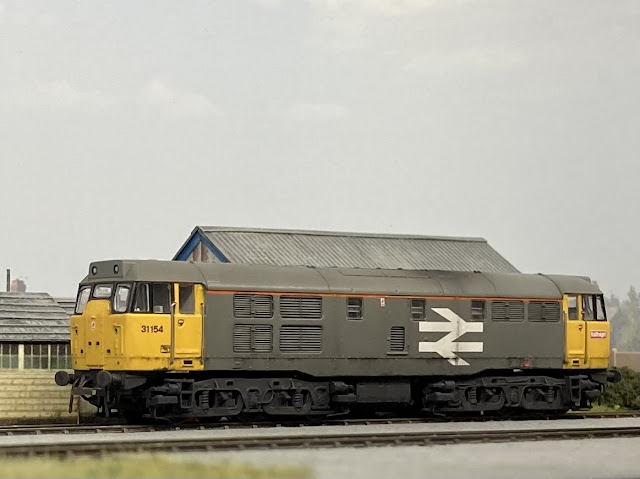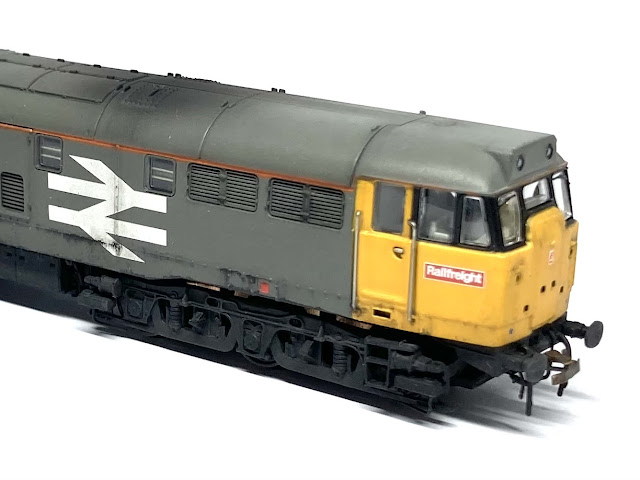Bland and boring: Railfreight 31 in N…
Bland, boring… beautiful? Perhaps not quite but certainly ‘just right’. Whilst allowing just a little scope creep (Paxton Road is Scotland, cough, in 1990) the Railfreight 31 is a little more ubiquitous whilst allowing the same palette of rolling stock…
A few months ago 31130 joined the ranks here, looking rather lovely in Railfreight coal livery. This had been an impulse purchase to some extent, I’d always loved them in coal colours and wanted a nuclear train but it was scope creep. I recently replaced the body with this Railfreight grey example. More boring, but more useful… why? This livery doesn’t tie me to one traffic nor does it tie me to a geographic location. Through the late 80s and early 90s the freight operations of these Type 2s became more localised as did their paint schemes - but the plain grey allows a little artistic licence in her use and sphere of operation.
I do love the way Farish models feel out of the box. There is a real lustre to the finish that just feels good quality. It almost seems a shame to weather them but 31154 faced the usual methods. Step one was to paint out the white cantrail stripe she has left the works after rebuild and repaint with - replaced with an orange one that was applied before 1990 (thanks to Flickr for the photo evidence). I used Humbrol 82 enamel in my Grandma’s bow pen, this flows well when thinned and application is quick and easy with the tool feeling comfortable, like an old friend, gently resting in my hand. In practice the grey paint on the roof of these locomotives faded to a paler blue green shade. I have found that Humbrol 28 is often a good fade, this was applied as a thin mix via airbrush to just the roof and sealed with a satin lacquer.
Weathering is just two shades, Humbrol, wait for it, yes, 33 and 98. Mixed on a palette as I go the natural tonal variation of oil and dirt can be replicated in most cases with these pair of colours. A thick wash is painted on panel lines and grills and a wide flat brush moistened in thinners works and removes this, the results continually adjusted whilst in the flow from years of experience and an almost embedded knowledge of the way dirt seems to collect and move around the bodies of British diesels.
This model is not pretty but to my nostalgic eye definitely wears its mundane charm with aplomb. Remember too, that the model is tiny, that these streaks and rust patches are so subtle - yet overall the model comes together as a realistic whole. Model railways are our escape, however we play with them they are a place where we are in control. Whilst you might enjoy collecting pristine box fresh models I have spent my life making them my own, and thus model is not just one of my childhood in time, it is also one that harks back to my Lima diesels. I look forward to sharing cameos on Paxton Road and beyond in the coming months - more on that another time, for now though, more soon…
I didn’t see many 31s until the 31/4s invaded the North Wales coast in the 1990s before themselves being usurped by the 37/4s… certainly nothing in Railfreight. Later Dutch examples were staple power to be seen at Crewe and Bescot on fly-by visits but the presence of 31271 here in the valley is a constant reminder of their strange character. They are ugly and attractive all at once, they look powerful, sound great but have a reputation for being light footed…
Particular attention is then paid, using a good photo or two, to add specific elements. In this case the 31 suffered from rust along the lower body seam around the cabs and from oil and grease seepage on this same seam in the engine bay. This was applied and adjusted with the same colours and brushes as the general weathering. By this time of their lives these machines had spent years idling in sidings and their exhausts were often some what dirty - leaving a filthy mess on their roofs in operation. Matt black was used to suggest a heavier deposit than usual, applied deftly with an airbrush.
Donate
I love writing and creating material for the blog. If you enjoy what you read and engage with I would be appreciative of any donation, large or small, to help me keep it advert and restriction free.






With the long life of certain classes it is amazing how different people can "discover" them many years apart. For me the 31s at new Street in the 70's represented a trip to somewhere I'd never been and was unlikely to make to Norwich - a city that I now have incredible memories of . As for Bescot, I got to wander around it freely, and officially in its heyday. Hard to believe now.what access you could get to depots and signalboxes . We even took over operating the Post Office railway for an hour. TBF half of the people involved in those trips went on to have long careers in the industry.
ReplyDeleteNostalgia is a peculiar drug. The 31s have their fans, I do enjoy seeing and hearing one hear a pleasure. This tiny model has been an enjoyable diversion from some of the other jobs I should probably be considering!
DeleteHi James
DeleteBland and boring often equates with typical and useful in railway terms and is none the worse for that. As I have said I never really took much notice of BR being more interested industrial systems and photographing some of the last steam. However I never overlooked the Ruston or Sentinel shunting the yard just because they were bland and boring - they were what made the system tick and often gave it a future.
Without real knowledge of Class 31's or any BR locos your treatment of models makes them look as I would imagine after time working freight around the country. I also admire the way your cameos can stand in for many parts of the country. The benefit of modelling the typical not the specific
Best regards
Alan
Hi Alan - yes, quite. That is all very true - you say one thing that sticks with me in particular, one to muse on... modelling the typical rather than specific. That is interesting, I will reflect on it!
DeleteHaving immersed myself recently in your blogposts and videos (and with your two books on order), I am beginning to see the attractions of (even) Class 31s and so much else besides. You offer a really appealing rationale for why even the most 'down at heal' scene can be engaging. I wonder if you are at all influenced by the more creative railway photographers of the last fifty years (most notably Colin T Gifford in the UK)? He composes as you do and has your artist's eye. Many thanks for this, and your many other blogposts.
ReplyDeleteHello Jonathan and welcome! I'm pleased to hear you're enjoying my material and even more that you've picked up the books - where I have longer to think about and muse on some of the same ideas. Enjoy them!
DeleteYou mention influence from railway photographers? Not so much - I interpret the reality I see through my own eyes, perhaps though, because of some of the 'rules' of the way we structure, frame and choreograph the scene there are accidental overlaps? All food for thought. Best, James!